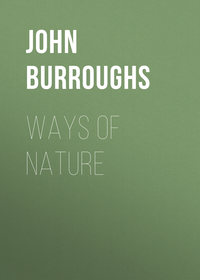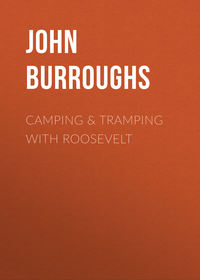 полная версия
полная версияRiverby
If we wish rightly to interpret nature, to get at the exact truth of her ways and doings, we must cultivate what is called the critical habit of mind; that is, the habit of mind that does not rest with mere appearances. One must sift the evidence, must cross-question the facts. This gentleman was a lawyer, but he laid aside the cunning of his craft in dealing with this question of these egg-shells.
The bending in, or the indented appearance of the edge of the shells was owing to the fact that the thin paper-like skin that lines the interior of the shell had dried and shrunken, and had thus drawn the edges of the shell inward. The cut was made by the beak of the young bird, probably by turning its head from right to left; one little point it could not reach, and this formed the hinge of the lid I have spoken of. Is it at all probable that if the mother bird had done this work she would have left this hinge, and left it upon every egg, since the hinge was of no use? The complete removal of the cap would have been just as well.
Neither is it true that the parent bird shoves its young from the nest when they are ready to fly, unless it be in the case of doves and pigeons. Our small birds certainly do not do this. The young birds will launch out of their own motion as soon as their wings will sustain them, and sometimes before. There is usually one of the brood a little more forward than its mates, and this one is the first to venture forth. In the case of the bluebird, chickadee, high-hole, nuthatch, and others, the young are usually a day or two in leaving the nest.
The past season I was much interested in seeing a brood of chickadees, reared on my premises, venture upon their first flight. Their heads had been seen at the door of their dwelling – a cavity in the limb of a pear-tree – at intervals for two or three days. Evidently they liked the looks of the great outside world; and one evening, just before sundown, one of them came forth. His first flight was of several yards to a locust, where he alighted upon an inner branch, and after some chirping and calling proceeded to arrange his plumage and compose himself for the night. I watched him till it was nearly dark. He did not appear at all afraid there alone in the tree, but put his head under his wing and settled down for the night as if it were just what he had always been doing. There was a heavy shower a few hours later, but in the morning he was there upon his perch in good spirits.
I happened to be passing in the morning when another one came out. He hopped out upon a limb, shook himself, and chirped and called loudly. After some moments an idea seemed to strike him. His attitude changed, his form straightened up, and a thrill of excitement seemed to run through him. I knew what it all meant; something had whispered to the bird, "Fly!" With a spring and a cry he was in the air, and made good headway to a near hemlock. Others left in a similar manner during that day and the next, till all were out.
Some birds seem to scatter as soon as they are out of the nest. With others the family keeps together the greater part of the season. Among birds that have this latter trait may be named the chickadee, the bluebird, the blue jay, the nuthatch, the kingbird, the phœbe-bird, and others of the true flycatchers.
One frequently sees the young of the phœbe sitting in a row upon a limb, while the parents feed them in regular order. Twice I have come upon a brood of young but fully fledged screech owls in a dense hemlock wood, sitting close together upon a low branch. They stood there like a row of mummies, the yellow curtains of their eyes drawn together to a mere crack, till they saw themselves discovered. Then they all changed their attitudes as if an electric current had passed through the branch upon which they sat. Leaning this way and that, they stared at me like frightened cats till the mother took flight, when the young followed.
The family of chickadees above referred to kept in the trees about my place for two or three weeks. They hunted the same feeding-ground over and over, and always seemed to find an abundance. The parent birds did the hunting, the young did the calling and the eating. At any hour in the day you could find the troop slowly making their way over some part of their territory.
Later in the season one of the parent birds seemed smitten with some fatal malady. If birds have leprosy, this must have been leprosy. The poor thing dropped down through a maple-tree close by the house, barely able to flit a few feet at a time. Its plumage appeared greasy and filthy, and its strength was about gone. I placed it in the branches of a spruce-tree, and never saw it afterward.
IIIA boy brought me a dead bird the other morning which his father had picked up on the railroad. It had probably been killed by striking the telegraph wires. As it was a bird the like of which he had never seen before, he wanted to know its name. It was a wee bird, mottled gray and brown like nearly all our ground birds, as the sparrows, the meadowlark, the quail: a color that makes the bird practically invisible to its enemies in the air above. Unlike the common sparrows, its little round wings were edged with yellow, with a tinge of yellow on its shoulders; hence its name, the yellow-winged sparrow. It has also a yellowish line over the eye. It is by no means a common bird, though there are probably few farms in the Middle and Eastern States upon which one could not be found. It is one of the birds to be looked for. Ordinary observers do not see it or hear it.
It is small, shy, in every way inconspicuous. Its song is more like that of an insect than that of any other of our birds. If you hear in the fields in May and June a fine, stridulous song like that of a big grasshopper, it probably proceeds from this bird. Move in the direction of it and you will see the little brown bird flit a few yards before you. For several mornings lately I have heard and seen one on a dry, gravelly hillock in a field. Each time he has been near the path where I walk. Unless your ear is on the alert you will miss his song. Amid the other bird songs of May heard afield it is like a tiny, obscure plant amid tall, rank growths. The bird affords a capital subject for the country boy, or town boy, either, when he goes to the country, to exercise his powers of observation upon. If he finds this bird he will find a good many other interesting things. He may find the savanna sparrow also, which closely resembles the bird he is looking for. It is a trifle larger, has more bay about the wings, and is more common toward the coast. Its yellow markings are nearly the same. There is also a variety of the yellow-winged sparrow called Henslow's yellow-winged sparrow, but it bears so close a resemblance to the first-named that it requires a professional ornithologist to distinguish them. I confess I have never identified it.
I never see the yellow-wing without being reminded of a miniature meadowlark. Its short tail, its round wings, its long and strong legs and feet, its short beak, its mottled coat, the touch of yellow, as if he had just rubbed against a newly-opened dandelion, but in this case on the wings instead of on the breast, the quality of its voice, and its general shape and habits, all suggest a tiny edition of this large emphatic walker of our meadows.
The song of this little sparrow is like the words "chick, chick-a-su-su," uttered with a peculiar buzzing sound. Its nest is placed upon the ground in the open field, with four or five speckled eggs. The eggs are rounder and their ground color whiter than the eggs of other sparrows.
I do not know whether this kind walks or hops. This would be an interesting point for the young observer to determine. All the other sparrows known to me are hoppers, but from the unusually long and strong legs of this species, its short tail and erect manner, I more than half suspect it is a walker. If so, this adds another meadowlark feature.
Let the young observer follow up and identify any one bird, and he will be surprised to find how his love and enthusiasm for birds will kindle. He will not stop with the one bird. Carlyle wrote in a letter to his brother, "Attempt to explain what you do know, and you already know something more." Bring what powers of observation you already have to bear upon animate nature, and already your powers are increased. You can double your capital and more in a single season.
The first among the less common birds which I identified when I began the study of ornithology was the red-eyed vireo, the little gray bird with a line over its eye that moves about with its incessant cheerful warble all day, rain or shine, among the trees, and it so fired my enthusiasm that before the end of the season I had added a dozen or more (to me) new birds to my list. After a while the eye and ear become so sensitive and alert that they seem to see and hear of themselves, and like sleepless sentinels report to you whatever comes within their range. Driving briskly along the road the other day, I saw a phœbe-bird building her nest under a cliff of rocks. I had but a glimpse, probably two seconds, through an opening in the trees, but it was long enough for my eye to take in the whole situation: the gray wall of rock, the flitting form of the bird and the half-finished nest into which the builder settled. Yesterday, May 7, I went out for an hour's walk looking for birds' nests. I made a tour of some orchards, pastures, and meadows, but found nothing, and then came home and found a blue jay's nest by my very door. How did I find it? In the first place my mind was intent upon nest finding: I was ripe for a bird's nest. In the second place I had for some time suspected that a pair of jays were nesting or intending to nest in some of the evergreens about my house; a pair had been quite familiar about the premises for some weeks, and I had seen the male feed the female, always a sure sign that the birds are mated, and are building or ready to build. Many birds do this. I have even seen the crow feed its mate in April. Just at this writing, a pair of chickadees attracted my attention in a spruce-tree in front of my window. One of them, of course the male, is industriously feeding the other. The female hops about, imitating the voice and manner of a young bird, her wings quivering, her cry plaintive, while the male is very busy collecting some sort of fine food out of the just bursting buds of the tree. Every half minute or so he approaches her and delivers his morsel into her beak. I should know from this fact alone that the birds have a nest near by. The truth is, it is just on the other side of the study in a small cavity in a limb of a pear-tree. The female is laying her eggs, one each day, probably, and the male is making life as easy for her as possible, by collecting all her food for her.
Hence, when as I came down the drive and a blue jay alighted in a maple near me, I paused to observe him. He wiped his beak on a limb, changed his position a couple of times, then uttered a low mellow note. The voice as of a young jay, tender and appealing, came out of a Norway spruce near by. The cry was continued, when the bird I was watching flew in amid the top branches, and the cry became still more urgent and plaintive. I stepped along a few paces and saw the birds, the female standing up in her nest and the male feeding her. The nest was placed in a sort of basket formed by the whorl of up-curving branches at the top of the tree, the central shaft being gone.
It contained four eggs of a dirty brownish greenish color. As I was climbing up to it, a turtle dove threw herself out of the tree and fluttered to the ground as if mortally wounded. My little boy was looking on, and seeing the dove apparently so helpless and in such distress, ran to see "what in the world ailed it." It fluttered along before him for a few yards, and then its mate appearing upon the scene, the two flew away, much to the surprise of the boy. We soon found the doves' nest, a shelf of twigs on a branch about midway of the tree. It held two young birds nearly fledged. How they seemed to pant as they crouched there, a shapeless mass of down and feathers, regarding us! The doves had been so sly about their nesting that I had never suspected them for a moment. The next tree held a robin's nest, and the nest of a purple finch is probably near by. One usually makes a mistake in going away from home to look for birds' nests. Search the trees about your door.
The blue jay is a cruel nest-robber, but this pair had spared the doves in the same tree, and I think they have made their peace with the robins, as I do not see the latter hustling them about any more. Probably they want to stand well with their neighbors, and so go away from home to commit their robberies.
IVIf a new bird appears in my neighborhood, my eye or ear reports it at once. One April several of those rare thrushes – Bicknell's or Slide Mountain thrush – stopped for two days in my currant-patch. How did I know? I heard their song as I went about the place, a fine elusive strain unlike that of any other thrush. To locate it exactly I found very difficult. It always seemed to be much farther off than it actually was. There is a hush and privacy about its song that makes it unique. It has a mild, fluty quality, very sweet, but in a subdued key. It is a bird of remote northern mountain-tops, and its song seems adjusted to the low, thick growths of such localities.
The past season a solitary great Carolina wren took up its abode in a bushy land near one corner of my vineyard. It came late in the season, near the end of August, the only one I had ever heard north of the District of Columbia. During my Washington days, many years ago, this bird was one of the most notable songsters observed in my walks. His loud, rolling whistle and warble, his jocund calls and salutations – how closely they were blended with all my associations with nature on the Potomac. When, therefore, one morning my ear caught the same blithe, ringing voice on the Hudson, be assured I was quickly on the alert. How it brought up the past. How it reopened a chapter of my life that had long been closed. It stood out amid other bird songs and calls with a distinctness that attracted the dullest ears. Such a southern, Virginia air as it gave to that nook by the river's side!
I left my work amid the grapes and went down to interview the bird. He peeped at me inquisitively and suspiciously for a few moments from a little clump of weeds and bushes, then came out in fuller view, and finally hopped to the top of a grape-post, drooped his wings and tail, lifted up his head, and sang and warbled his best. If he had known exactly what I came for and had been intent upon doing his best to please me, he could not have succeeded better.
The great Carolina wren is a performer like the mockingbird, and is sometimes called the mocking wren. He sings and acts as well. He seems bent on attracting the attention of somebody or something. A Southern poet has felicitously interpreted certain notes by the words, "Sweetheart, sweetheart, sweet."
Day after day and week after week, till the frosts of the late October came, the bird tarried in that spot, confining his wanderings to a very small area and calling and warbling at all hours. From my summer-house I could often hear his voice rise up from under the hill, seeming to fill all the space down there with sound. What brought this solitary bird there, so far from the haunts of his kind, I know not. Maybe he was simply spying out the land, and will next season return with his mate. Mockingbirds have wandered north as far as Connecticut, and were found breeding there by a collector, who robbed them of their eggs. The mocking wren would be a great acquisition to our northern river banks and bushy streams. It is the largest of our wrens, and in the volume and variety of its notes and the length of its song season surpasses all others.
A lover of nature never takes a walk without perceiving something new and interesting. All life in the winter woods or fields as revealed upon the snow, how interesting it is. I recently met a business man who regularly goes camping to the Maine woods every winter from the delight he has in various signs of wild life written upon the snow. His morning paper, he says, is the sheet of snow which he reads in his walk. Every event is chronicled, every new arrival registers his name, if you have eyes to read it!
In December my little boy and I took our skates and went a mile distant from home into the woods to a series of long, still pools in a wild, rocky stream for an hour's skating. There was a light skim of snow upon the ice, but not enough to interfere seriously with our sport, while it was ample to reveal the course of every wild creature that had passed the night before. Here a fox had crossed, there a rabbit or a squirrel or a muskrat.
Presently we saw a different track and a strange one. The creature that made it had come out of a hole in the ground about a yard from the edge of the long, narrow pool upon which we were skating, and had gone up the stream, leaving a track upon the snow as large as that of an ordinary-sized dog, but of an entirely different character.
We had struck the track of an otter, a rare animal in the Hudson River Valley; in fact, rare in any part of the State. We followed it with deep interest; it threw over the familiar stream the air of some remote pool or current in the depths of the Adirondacks or the Maine woods. Every few rods the otter had apparently dropped upon his belly and drawn himself along a few feet by his fore paws, leaving a track as if a log or bag of meal had been drawn along there. He did this about every three rods.
At the head of the pool where the creek was open and the water came brawling down over rocks and stones, the track ended on the edge of the ice; the otter had taken to the water. A cold bath, one would say, in mid-December, but probably no colder to him than the air, as his coat is perfectly waterproof.
On another pool farther up the track reappeared, and was rubbed out here and there by the same heavy dragging in the snow, like a chain with a long solid bar at regular distances in place of links. At one point the otter had gone ashore and scratched a little upon the ground. He had gone from pool to pool, taking the open rapids wherever they appeared.
The otter is a large mink or weasel, three feet or more long and very savage. It feeds upon fish, which it seems to capture with ease. It is said that it will track them through the water as a hound tracks a fox on land. It will travel a long distance under the ice, on a single breath of air. Every now and then it will exhale this air, which will form a large bubble next the ice, where in a few moments it becomes purified and ready to be taken into the creature's lungs again. If by any accident the bubble were to be broken up and scattered, the otter might drown before he could collect it together again. A man who lived near the creek said the presence of the otter accounted for the scarcity of the fish there.
VThe other day one of my farmer neighbors asked me if I had seen the new bird that was about. This man was an old hunter, and had a sharp eye for all kinds of game, but he had never before seen the bird, which was nearly as large as a robin, of a dull blue or slate color marked with white.
Another neighbor, who was standing by, said the bird had appeared at his house the day before. A cage with two canaries was hanging against the window, when suddenly a large bird swooped down as if to dash himself against it; but arresting himself when near the glass, he hovered a moment, eying the birds, and then flew to a near tree.
The poor canaries were so frightened that they fell from their perches and lay panting upon the floor of their cage.
No one had ever seen the bird before; what was it? It was the shrike, who thought he was sure of a dinner when he saw those canaries.
If you see, in late autumn or winter, a slim, ashen-gray bird, in size a little less than the robin, having white markings, flying heavily from point to point, and always alighting on the topmost branch of a tree, you may know it is the shrike.
He is very nearly the size and color of the mockingbird, but with flight and manners entirely different. There is some music in his soul, though his murderous beak nearly spoils it in giving it forth.
One winter morning, just at sunrise, as I was walking along the streets of a city, I heard the shrike's harsh warble. Looking about me, I soon saw the bird perched upon the topmost twig of a near tree, saluting the sunrise. It was what the robin might have done, but the strain had none of the robin's melody.
Some have compared the shrike's song to the creaking of a rusty gate-hinge, but it is not quite so bad as that. Still it is unmistakably the voice of a savage. None of the birds of prey have musical voices.
The shrike had probably come to town to try his luck with English sparrows. I do not know that he caught any, but in a neighboring city I heard of a shrike that made great havoc with the sparrows.
VIWhen Nature made the flying squirrel she seems to have whispered a hint or promise of the same gift to the red squirrel. At least there is a distinct suggestion of the same power in the latter. When hard pressed the red squirrel will trust himself to the air with the same faith that the flying squirrel does, but, it must be admitted, with only a fraction of the success of the latter. He makes himself into a rude sort of parachute, which breaks the force of his fall very much. The other day my dog ran one up the side of the house, through the woodbine, upon the roof. As I opened fire upon him with handfuls of gravel, to give him to understand he was not welcome there, he boldly launched out into the air and came down upon the gravel walk, thirty feet below, with surprising lightness and apparently without the least shock or injury, and was off in an instant beyond the reach of the dog. On another occasion I saw one leap from the top of a hickory-tree and fall through the air at least forty feet and alight without injury. During their descent upon such occasions their legs are widely extended, their bodies are broadened and flattened, the tail stiffened and slightly curved, and a curious tremulous motion runs through all. It is very obvious that a deliberate attempt is made to present the broadest surface possible to the air, and I think a red squirrel might leap from almost any height to the ground without serious injury. Our flying squirrel is in no proper sense a flyer. On the ground he is more helpless than a chipmunk, because less agile. He can only sail or slide down a steep incline from the top of one tree to the foot of another. The flying squirrel is active only at night; hence its large, soft eyes, its soft fur, and its gentle, shrinking ways. It is the gentlest and most harmless of our rodents. A pair of them for two or three successive years had their nest behind the blinds of an upper window of a large, unoccupied country house near me. You could stand in the room inside and observe the happy family through the window pane against which their nest pressed. There on the window sill lay a pile of large, shining chestnuts, which they were evidently holding against a time of scarcity, as the pile did not diminish while I observed them. The nest was composed of cotton and wool which they filched from a bed in one of the chambers, and it was always a mystery how they got into the room to obtain it. There seemed to be no other avenue but the chimney flue.
There are always gradations in nature, or in natural life; no very abrupt departures. If you find any marked trait or gift in a species you will find hints and suggestions of it, or, as it were, preliminary studies of it, in other allied species. I am not thinking of the law of evolution which binds together the animal life of the globe, but of a kind of overflow in nature which carries any marked endowment or characteristic of a species in lessened force or completion to other surrounding species. Or if looked at from the other way, a progressive series, the idea being more and more fully carried out in each succeeding type – a kind of lateral and secondary evolution. Thus there are progressive series among our song-birds. The brown thrasher is an advance upon the catbird, and the mockingbird is an advance upon the brown thrasher in the same direction. Each one carries the special gift of song or mimicking some stages forward. The same among the larks, through the so-called meadowlark and the shore lark, up to the crowning triumph of the skylark. The nightingale also finishes a series which starts with the hedge warbler and includes the robin redbreast. Our ground-sparrow songs probably reach their highest perfection in the song of the fox sparrow; our finches in that of the purple finch, etc.









